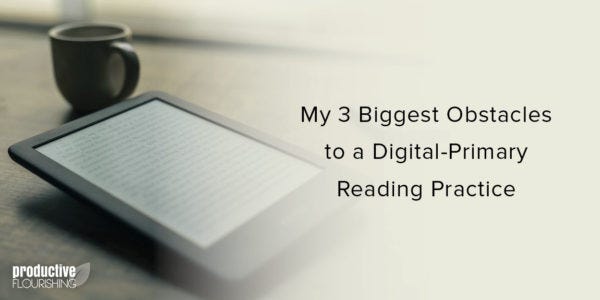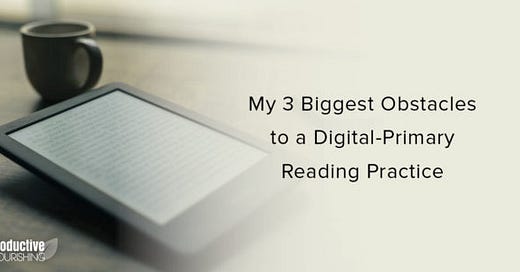My 3 Biggest Obstacles to a Digital-Primary Reading Practice

In June 2021, I started the process of habituating myself to effectively read from digital sources. Specifically, I’m working on encoding and referencing the information. I read a lot on a screen, but I don’t retain it and I don’t have a good process for finding my references compared to how I do this with the information I print out or read from physical books.
I have nearly four decades of habits, practices, and biases around reading physical books; it’s not a stretch to say I’m optimized for it, given that I read 5–15 books a month depending on what’s going on. And that doesn’t count all the articles and emails I print out. (Yes, print out.)
Because slowly integrating digital reading is mostly having me return to what's more familiar, I've decided to invert my processes so that I default to digital reading. I suspect it'll take me at least a year to habituate myself to digital-primary reading.
My 3 biggest obstacles to digital-primary reading can be summarized as Where, When, and How:
1. Where – I don't carry a digital reading device on me everywhere. Yes, including my phone. When I want to read, I have to go find it, and then turn the device to the book I want to read. That introduces a lot of friction and, like most things, the more friction in a process, the less likely it is to happen.
With physical reading, I unconsciously but strategically place physical books and printouts where I’m most likely to want to read them. Wisdom books go on the nightstand; technical business books go in the library; pop-in non-fiction books go downstairs so I can read in 10-15 minute slices when I’m waiting on something else. No matter where I am, the right book is in reach when I want to read.
2. When – I intentionally avoid devices in the time slots I'm most primed to read. I'm careful not to engage with devices in the morning because it's so easy to get distracted and, per the above, I'm not carrying a device with me for the liminal reading that happens with books. Wisdom reading still happens, albeit slowly, because Kindle Paperwhites are allowed in our bedroom (where all other devices aren't).
With physical reading, I don't have to compromise the location-based choice architecture that removes digital devices to make deep thinking, writing, and reading the defaults.
3. How – It's hard to read multiple books in different phases with digital books. My hypothesis is that my encoding challenges from digital reading partly come from the fact that I don’t have the structural and holistic view of the work as I’m reading any part of it, so my brain’s trying to figure out how a paragraph or sentence relates to the whole.
With physical reading, I read multiple books at a time, with each book going through different phases. The first phase is a structural skim, reading chapter summaries, and flipping through to find interesting parts I want to come back to. During the second phase, I’m still skimming, but a bit slower, and I’m covering the parts that are interesting. If it’s a really interesting book, I’ll then read more slowly and front to back.
At this point, my intentional digital minimalism and choice architecture are at odds with digital-primary reading. I'll give an update next month on how it's going.
If you've overcome these obstacles, I'd love to know how. :)




